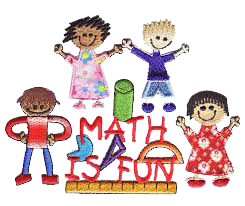School Day (within 100)
KNPIG ID #T 5520.4
What's this activity about?
A classic board game is transformed into an engaging math story about your child’s school day using the concept of tracking money transactions. She or he will be practicing adding and subtracting one and two digit numbers while working their way around a game board, collecting rewards for positive school deeds or paying in the opposite situation. This is a great game to play with your child and an opportunity to model good mathematical practices, and promote important life skills.
Game adapted from Scotty Bratcher's (Grayson County Public Schools) Original Version.
What materials do we need?
School Day game board (printable from file)
Checkbook (printable from file, or create your own on paper) –OR- use pennies and dimes (see “Where’s the Math?”) Pawns/game pieces
Dot Die

How do we play?
All players place their pawns on the payday space. Each player starts with four dimes. The youngest player goes first by rolling the dot die and moving his/her pawn that number of spaces. Each player will read the space and record the value they will “add to” or “take away” on their recording sheet. Players will then find their total amount of money and record how many hundreds, tens, and ones they have on to their recording sheet. If a player lands on a “chance” space they will follow the directions in the middle of the board (roll the dot dice and follow the directions). Each player gets paid four dimes as they pass payday. The player with the most money at the end of the game wins. Length of gameplay can be determined by number of turns or amount of time.
Checkbook:
- Each player will be using a checkbook with a starting value of 40 cents or 4 dimes. This value is already on the checkbook in space one.
- If a player lands on a “pay” space they will write the activity (ex. late for school) and the number in the “take away” space on their checkbook. The student will then subtract that number from their previous total and record their new total on their checkbook. Once a new total has been found the student will determine how many tens and ones make up that number.
- If a player lands on a “Collect” they will write the activity (ex. birthday!) and the number in the “add to” space on their checkbook. The student will then add that number to their previous total and record their new total in the space on their checkbook. Once a new total has been found the student will determine how many tens and ones make up that number.
- The top three lines on the checkbook are examples of how to use the sheet.
Where’s the Math?
There is a lot of math in this game that reinforces what your child is learning in school. You child is being challenged to work with tens and ones without using paper and pencil. He or she should become comfortable adding and subtracting these numbers in their head by using strategies they have learned in school. If your child is having trouble using the check book, it might be a good idea to use actual pennies and dimes before introducing the checkbook. Talk to your child about exchanging ten pennies for a dime. This is a very conceptual structure and is a big step for children because they cannot “see” the ten pennies in a dime; it is a concept they have to imagine. Follow this link for a great resource for children who need extra support for understanding that a single coin can represent many pennies- http://www.kentuckymathematics.org/docs/coins_for_unitary_thinkers.doc
Things to Think About:
This activity is a great conversation starter. When working with the checkbook, you can talk to your child about the importance of keeping track of their money and how what you are practicing now is a real life skill people use every day. Grownups use this mental math strategies when adding up groceries, paying bills and seeing if they have enough money to take their children to the movies! Also, you can spark conversations about your child’s actual school day without much effort. The prompts on the spaces may remind your child of something similar that happened during their own school day.
This game is very playable and will keep you and your child engaged. The whole family can play this game and can be a challenge for all people. Modeling while you play is very important if your child is struggling at first. Say out loud how you are thinking through your problems, so your child becomes comfortable using their own strategies. This will also encourage them to narrate as they think, so you see how they are most comfortable working through two digit addition and subtraction problems.
Feedback
Send us your thoughts and ideas about these activities. Email the KCM

